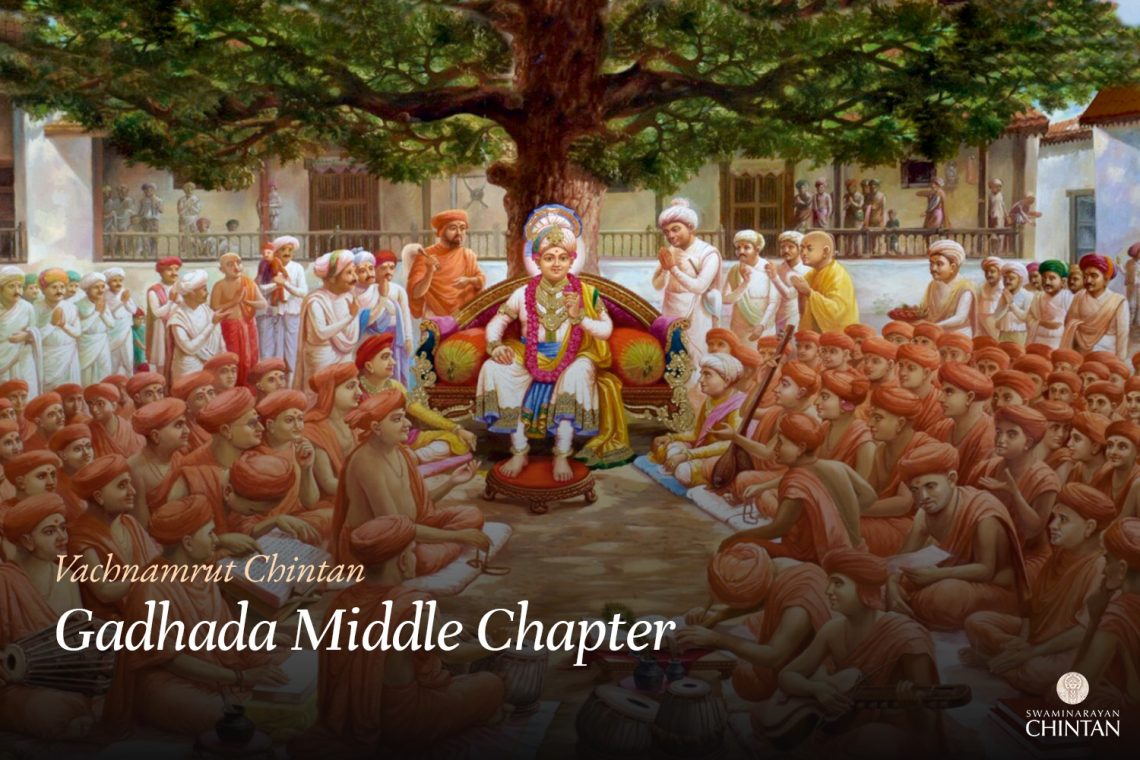Central Insights:
- The attachment of family relations.
Key Points:
- Attachment to family relations is like the branch of a thor (cactus) tree, which grows even without being nurtured.
- Only by establishing a true connection with Bhagwan through upasana (worship) of Maharaj can one remove such attachment.
Explanation:
This Vachanamrut is referred to as the “Vachanamrut of the Thorn Tree.” Maharaj explains that in this world, family relations are like the branches of a thor tree, or the branches of a vata (banyan) or pipal tree. Even if you cut them off at the root, they do not stop growing. A piece of thor lying on the ground, even on a stone surface or pavement, will eventually grow into a tree when it finds favorable conditions like water, even after lying in the sun for a long time. It does not require soil, as it can find everything it needs to survive on its own. Similarly, family attachment is like the thor tree—it revives even without nurturing. This is especially relevant for tyagis (renunciants), which is why Maharaj addresses this issue particularly in Vach.G.L.19.
Maharaj described that a tyagi who still has attachment to their family appears to Him as nothing more than an animal. Animals do not care for their relatives, and if an animal faces danger, its relatives do not come to its aid. Yet, if you approach a cow’s newborn calf, the cow will charge at you, or if you go near a dog’s freshly born puppies, the dog will attack. Why do animals behave this way? It is not out of any calculated benefit or reason; it is purely out of moh (delusion) or by Bhagwan’s natural order. Similarly, a tyagi‘s attachment to family is also driven by an animal-like intellect.
In Vach.G.F.34, Maharaj states that Bhagwan has established such a natural order so that there is no need to restart creation repeatedly, allowing the world to continue growing. If humans thought logically about the effort they put into raising one child, they would realize that the effort is disproportionately large compared to the outcomes. But this does not happen because the attachment happens naturally through Bhagwan’s divine kala (power or art). Only those who are not swept away by this current of attachment can truly become devotees of Bhagwan. This is why Maharaj labels a tyagi with attachment to family as an animal—like an animal, they act without thought.
In Vach.G.F.3, Maharaj says that it is very difficult to forget one’s birthplace and associations. Only through true gnan (knowledge) can this be achieved. Here too, Maharaj emphasizes that by seeing oneself as distinct from the body and by focusing on the murti (image) of Bhagwan, one can discard all forms of pride and relationships, including family attachments. There is a saying, “Even a camel turns back toward Marwad,” meaning one’s connection to their birthplace is never forgotten. Even after spending decades in the tyag ashram, when a person leaves and encounters certain conditions, they remember their family, even after 30–40 years. Therefore, it is very difficult to distance oneself internally from such attachments. However, by understanding the greatness of Maharaj and following His teachings, one can, through the grace of Bhagwan and the sants, remove these attachments.
Maharaj also says that the liberation of the soul, its ability to cross Maya, and the attainment of Brahm-status is only possible through gyan, dhyan (meditation), kirtan (devotional songs), and katha (spiritual discourses) focused on Purushottam Vasudev Bhagwan—that is, Maharaj Himself. Through this, the soul crosses Maya and attains the highest spiritual state and reaches Akshardham.
Atmanishtha (steadfastness in one’s identity as the soul), vairagya (detachment), and dharma (righteous duty) are aids to devotion, but without bhakti (devotion), they alone cannot help the soul cross Maya. Even if one has only devotion, the soul can still cross Maya. The support of dharma and other qualities helps ensure that no obstacles arise in bhakti. Without this support, adverse conditions of desh (place), kal (time), etc., can obstruct one’s devotion. Thus, it is essential to practice devotion along with dharma, and one should never engage with evil desh, kal, or associations, as doing so hinders crossing Maya.
Glossary
| Thor Tree – A cactus tree Used as a metaphor for family attachment, which grows even without nurturing and is difficult to eliminate. |
| Moh – Delusion A state where one cannot distinguish between appropriate and inappropriate actions, often caused by attachment. |
| Tyagi – Renunciant |
| Gyan – Knowledge |
| Dhyan – Meditation Deep concentration on Bhagwan’s divine form. |
| Kirtan – Devotional songs Singing praises of Bhagwan, which help focus the senses and mind on Him. |
| Katha – Spiritual discourse |
| Marwad – A person’s birthplace Symbolizes deep-rooted connections to one’s origins, which are difficult to forget |
| Akshardham – The eternal supreme abode of Bhagwan Swaminarayan The divine realm where Bhagwan Swaminarayan resides along with Akshar Muktas (Divine Liberated Souls) |
| Purushottam Vasudev – Supreme Bhagwan Refers to Maharaj (Bhagwan Swaminarayan) Himself, the central focus for liberation and devotion. |
| Atmanishtha – Steadfastness in the realization of the soul The firm realization and understanding of the soul’s true nature, living beyond the influence of three kinds of body |
| Vairagya – Detachment From Everything Except God |
| Dharma – Righteous duty Actions aligned with spiritual principles that support devotion and prevent obstacles. |
| Bhakti – Devotion Loving and selfless worship of God. |
| Maya – Illusion The material energy that entangles the Jeev in worldly existence and distracts from Bhagwan. |
| Desh – Place The environment in which a person resides, which influences their thoughts and behavior. |
| Kal – Time The influence of the time period or era on a person’s tendencies and inclinations. |

